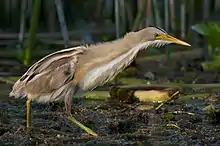Bittern
Bitterns are birds belonging to the subfamily Botaurinae of the heron family Ardeidae. Bitterns tend to be shorter-necked and more secretive than other members of the family. They were called hæferblæte in Old English; the word "bittern" came to English from Old French butor, itself from Gallo-Roman butitaurus, a compound of Latin būtiō (buzzard) and taurus (bull).[1]
| Bitterns | |
|---|---|
 | |
| American bittern | |
| Scientific classification | |
| Domain: | Eukaryota |
| Kingdom: | Animalia |
| Phylum: | Chordata |
| Clade: | Dinosauria |
| Class: | Aves |
| Order: | Pelecaniformes |
| Family: | Ardeidae |
| Subfamily: | Botaurinae Reichenbach, 1850 |
| Genera | |
| |
Bitterns usually frequent reed beds and similar marshy areas and feed on amphibians, reptiles, insects, and fish.
Bitterns, like herons, egrets, and pelicans, fly with their necks retracted, unlike the cranes, storks, ibises and spoonbills, which fly with necks extended and outstretched.
Species
There are currently 14 species divided into three genera within Botaurinae:
| Image | Genus | Living species |
|---|---|---|
 | Ixobrychus Billberg, 1828 |
|
.jpg.webp) | Botaurus Stephens, 1819 |
|
 | Zebrilus Bonaparte, 1855 |
|
Notes
Wikimedia Commons has media related to Botaurinae.
- Joseph P. Pickett; et al., eds. (2000). "Bittern". The American Heritage Dictionary of the English Language (4th ed.). Boston: Houghton Mifflin. Archived from the original on 2005-01-16. Retrieved 2006-07-04.
This article is issued from Wikipedia. The text is licensed under Creative Commons - Attribution - Sharealike. Additional terms may apply for the media files.